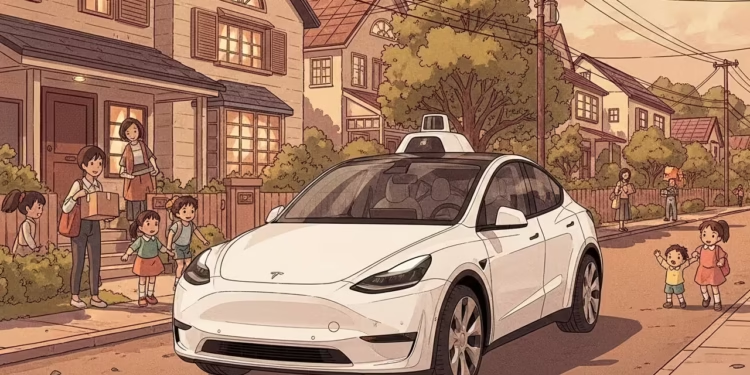BREAKING: On June 27, 2025, Tesla reached a historic milestone by delivering the world’s first completely autonomous vehicle from the factory to a customer’s home. CEO Elon Musk said the Model Y was able to drive on highways and city streets without any human help or remote control.
“Just a day ahead of schedule, the first fully automated delivery of a Tesla Model Y from the factory to a customer’s home across town, including highways, was finished!”
Musk said on X that “there were no people in the car at all and no remote operators in control at any point.”
A Big Step Forward in Autonomous Technology
The delivery that changed the game came from Tesla’s Gigafactory in Austin, Texas. The Model Y took around 30 minutes to get to its new owner’s house. The car could go up to 72 mph while driving through parking lots, highways, and city streets all on its own.
Ashok Elluswamy, Tesla’s Head of AI, said that the car used the Robotaxi version of FSD software, which is a specific self-driving system that not all Tesla owners can use currently. This powerful software is the result of years of work on Tesla’s Full Self-Driving capabilities. It shows Level 4 autonomy, which means that the car can do all driving responsibilities on its own under certain situations.
Tesla’s autonomous operations already transferred cars from production lines to delivery lots at the factory. This is a step ahead beyond that. But this is the first time a Tesla has driven on public roads without any help from anyone else to deliver something.
The Competitive Landscape and the Industry Context
Tesla’s announcement comes at a time when competition in the self-driving car market is getting stronger. Waymo and other firms have shown similar self-driving skills using a combination of lidar, radar, and cameras, but Tesla’s success is based only on its camera-based vision system.
The milestone comes after Tesla’s limited Robotaxi service started in Austin on June 22. Right now, it only works with human safety supervisors for a few investors and influencers. This delivery worked without any human monitoring, unlike the supervised Robotaxi service, which was a big step forward in technology.
Experts in the field still disagree over what it means. Some people think this proves Tesla’s vision-only approach to self-driving cars, but others are worried about how safe and scalable camera-only systems are compared to systems with several sensors. The rules and regulations are especially hard to deal with because existing U.S. laws say that self-driving cars on public highways must be watched by people.
Safety and Technical Innovation
The successful delivery shows off Tesla’s own AI processors and neural network technologies, which are made to help people make decisions quickly and safely on the roadway. The car’s ability to keep going at high speeds while dealing with complicated traffic situations shows that it has made a lot of progress in detecting obstacles and planning paths.
But this accomplishment brings up serious safety and regulatory issues. The National Highway Traffic Safety Administration (NHTSA) is looking into Tesla’s Full Self-Driving software after certain safety problems, and its delivery without supervision may make authorities rethink the rules they already have.
The way Tesla does things is very different from how other markets are regulated. Recent rules in China have banned unsupervised autonomous features and required strong driver monitoring systems. This shows how complicated the worldwide legal landscape is for self-driving cars.
Economic and Strategic Effects
This development might have a big effect on Tesla’s business model and the car industry as a whole. Self-driving deliveries promise to cut expenses by doing rid of the requirement for delivery people. This might lower the price of vehicles for consumers while raising the profit margins for manufacturers.
The technology gives Tesla other ways to make money outside selling cars. The business’s objective is to make logistics and ride-sharing services more autonomous, which would make it both an automobile and technology company.
But Tesla is having more and more problems with its regular electric vehicle business. Sales have dropped in important countries like North America and Europe, and the corporation is losing executives as it moves toward automation and robotics.
Answering Important Questions
How is this different from other demonstrations of self-driving cars?
Tesla says that this delivery worked completely on its own on public roads without any human supervision, unlike prior demonstrations that used pre-mapped routes or remote monitoring.
What clearances from the government were needed?
The delivery took place in a geofenced area of Austin, Texas, where Tesla has gotten permission to test self-driving cars. However, rules for self-driving cars that don’t need supervision are still being worked on.
When will people be able to use this technology?
Tesla hasn’t said when the Robotaxi FSD software would be available to all owners. Reports say that the vehicle’s software was rolled back to standard FSD v13 after delivery.
What does this mean for safety?
Tesla talks a lot about tight safety rules, but the fact that there is no human monitoring makes many wonder if the system can manage unexpected situations, which is why regulators are keeping a close eye on it.
The Future of Self-Driving Cars
Tesla’s historic achievement is a turning point in the development of self-driving cars since it shows that they can operate on public roads without any supervision. The successful delivery proves that years of investment in AI technology were worth it and puts Tesla at the vanguard of the autonomous revolution.
But for broad use to happen, big problems like getting regulatory permission, getting people to accept it, and proving that it’s safe will have to be solved. As the technology gets better, it will change not only how cars are delivered, but also the whole transportation system, including:
- Personal mobility
- Logistics
- Ride-sharing services
The milestone sets a new standard for the industry and shows how different technologies are still being debated when it comes to self-driving cars. As Tesla keeps pushing the limits, the next few months will be very important in figuring out if this breakthrough leads to more commercial success and regulatory approval.






